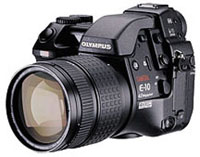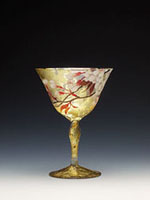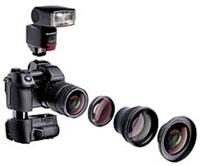Olympus Camedia E10 4MP SLR
First, I must express my gratitude to Olympus. A few years ago when rumors of digital backs for 35mm SLRs first cropped up, I responded in print with the opinion that eventually cameras designed for and around a CCD chip would prevail. The new Olympus Camedia E-10 realizes that prediction by being the first real camera you don't have to apologize for by referring to the output with the excuse, "it's digital." There's no compromise in the way it handles and the functions it provides. It has the optics, the body, the operating modes, the viewing system, light metering and autofocus, as well as a full compliment of traditional manual controls that we have come to expect in an advanced contemporary camera of any kind. The SLR Experience |
|||
Olympus Camedia E-10 Features The lens is a fast (f/2 to f/2.4) 4x zoom that has a range equal to 35-140mm for a 35mm SLR. This is an entirely new optical design with ED glass and aspheric elements configured specifically to match the unique attributes required to expose a CCD array. It is supplemented by wide angle, telephoto, and macro accessory attachments that screw into the 62mm adapter ring on the front of the E-10 zoom. Two lens barrel rings provide zoom control as well as manual focus. The focus mode is switched by a handy lever on the left side of the body. In the auto setting the overall scene rough focus is established with an infrared sensor. Fine adjustment is then made from information captured by the camera's CCD sensor array. |
|||
Well, we're halfway through the year 2001 and I'm finally getting used to the idea of living at the start of a new century. When we're all tucked away in the old photographers home we'll look back on this period as a time of major turmoil and exciting new opportunities in the photo world. There's new technology, new ways to view images, and new ways to take images. What has remained pretty constant is the desire of buyers of photography--magazines, ad agencies, graphic design firms, etc.--to look for the latest and freshest images. My work is subject to the same scrutiny as any other artist. If I were to stick with the style and look that made me so successful in the 1980s I surely would have a hard time finding any work. Even if I had kept my style static from the '90s I would find more and more clients looking for something newer and fresher. Don't get me wrong. Slavishly following trends and creating a raft of "me-too" images will get your portfolio bounced just as fast as a bunch of amateur snapshots. Like any artist I'm affected by the culture around me. I react to the slow but steady style shift that affects all artistic endeavors. My work has evolved over the years, even though it was hard to notice as it happened. Recently I assembled a new portfolio for my rep to show to prospective clients. The difference in styles became readily apparent. As I pulled out 10-year-old ads and replaced them with work from 2000 and 2001 I noticed a strong trend that has crept into my work--color. I don't mean bright color, I mean a strong, saturated fluid sense of color that most working pros today have to be able to create if they want to work. Exposure Metering & Modes |
|||
Finally and most significantly, once an exposure is made, you can switch to playback and, if set up, click the info button to see a histogram of the exposure overlaying the image as it is displayed in the LCD screen. This will confirm if the exposure is entirely within the gamut of the CCD's range. Color balance is established by default automatic white balance. In addition, the white balance can be set to a range of color temperatures from 3000-7500K. All of these mode settings and exposure values can be set by pressing the appropriate control button and then turning the main control knob immediately behind the shutter release. The readout of values is displayed in the small settings LCD display between the Mode control knob and penta-prism. A symbol in the LCD panel and the information bar under the focus screen in the viewfinder reminds you of your setting. There is also an auxiliary control knob on the back of the camera immediately below the information LCD display. When the exposure Mode is set to manual, the main control knob sets the shutter speed, while the one on the back sets the aperture value. E-10 Digital Features The standard power supply is two CR-3V lithium batteries, which may be substituted with four Ni-MH rechargeable batteries. There is also an optional rechargeable lithium polymer battery that is part of a vertical handgrip accessory. In addition a 110v AC adapter is available to power the camera. The Olympus E-10 computer connection is by a USB cable supplied with the camera. Image file downloading, as well as basic image-editing functions, are provided by Olympus Camedia software for Microsoft Windows and Apple Macintosh platforms. Also included in the camera is a video out socket for connection to a TV monitor providing a standard NTSC signal for monitor playback of images stored in camera memory (SmartMedia or CompactFlash card). The camera includes 32MB of SDRAM memory, which supports rapid sequence exposures at 3 fps up to four frames in a burst. Unlike many digital cameras, the shutter release delay is under 10 milliseconds, shorter than many film cameras. |
|||
Test Shooting The Olympus
E-10 I began with several days in the field making photographs of every kind of subject, including a new industrial building, agricultural scenes, a house under construction, another that needed to be condemned, and a new car. Nothing particularly original nor exciting, but after checking the exposures and downloading the images to Photo-shop an incredible level of consistency was established. In the process I gathered some more interesting images that also demonstrated a wide range of Olympus E-10 capabilities. I then was convinced that it was time to get serious about seeing what the E-10 would do as a studio camera with controlled, multiple electronic flash lighting. So I arranged a still life and a portrait session. This pair of test productions was photographed with the Olympus E-10 and a professional 35mm camera, a 100mm macro lens, loaded with Kodak Supra 100 film. The film results were scanned at 4000dpi. The selected E-10 images were transferred to Photoshop and enlarged by bipolar interpolation to 12x16" by 240dpi. Comparison prints between the film scans and the E-10 images were then made with an Epson Stylus Photo 1270 on 13x19" paper. Conclusion And Recommendation After the experience using the E-10, I can't help but feel that I'd sure have enjoyed what I've done photographically all my life a lot more if there was a camera such as the E-10 available. The bonus is the digital advantages it offers. For more information, contact Olympus America Inc. at (800) 347-4027, or visit their web site at: www.olympus.com. |
|||
Technical Specifications |
- Log in or register to post comments







































